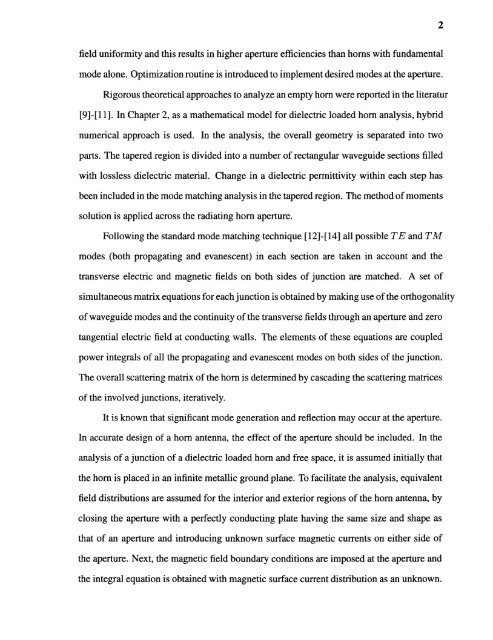Variable permittivity dielectric material loaded stepped-horn antenna
Variable permittivity dielectric material loaded stepped-horn antenna
Variable permittivity dielectric material loaded stepped-horn antenna
You also want an ePaper? Increase the reach of your titles
YUMPU automatically turns print PDFs into web optimized ePapers that Google loves.
2field uniformity and this results in higher aperture efficiencies than <strong>horn</strong>s with fundamentalmode alone. Optimization routine is introduced to implement desired modes at the aperture.Rigorous theoretical approaches to analyze an empty <strong>horn</strong> were reported in the literatur[9]-[11]. In Chapter 2, as a mathematical model for <strong>dielectric</strong> <strong>loaded</strong> <strong>horn</strong> analysis, hybridnumerical approach is used. In the analysis, the overall geometry is separated into twoparts. The tapered region is divided into a number of rectangular waveguide sections filledwith lossless <strong>dielectric</strong> <strong>material</strong>. Change in a <strong>dielectric</strong> <strong>permittivity</strong> within each step hasbeen included in the mode matching analysis in the tapered region. The method of momentssolution is applied across the radiating <strong>horn</strong> aperture.Following the standard mode matching technique [12]-[14] all possible TE and TMmodes (both propagating and evanescent) in each section are taken in account and thetransverse electric and magnetic fields on both sides of junction are matched. A set ofsimultaneous matrix equations for each junction is obtained by making use of the orthogonalityof waveguide modes and the continuity of the transverse fields through an aperture and zerotangential electric field at conducting walls. The elements of these equations are coupledpower integrals of all the propagating and evanescent modes on both sides of the junction.The overall scattering matrix of the <strong>horn</strong> is determined by cascading the scattering matricesof the involved junctions, iteratively.It is known that significant mode generation and reflection may occur at the aperture.In accurate design of a <strong>horn</strong> <strong>antenna</strong>, the effect of the aperture should be included. In theanalysis of a junction of a <strong>dielectric</strong> <strong>loaded</strong> <strong>horn</strong> and free space, it is assumed initially thatthe <strong>horn</strong> is placed in an infinite metallic ground plane. To facilitate the analysis, equivalentfield distributions are assumed for the interior and exterior regions of the <strong>horn</strong> <strong>antenna</strong>, byclosing the aperture with a perfectly conducting plate having the same size and shape asthat of an aperture and introducing unknown surface magnetic currents on either side ofthe aperture. Next, the magnetic field boundary conditions are imposed at the aperture andthe integral equation is obtained with magnetic surface current distribution as an unknown.
















